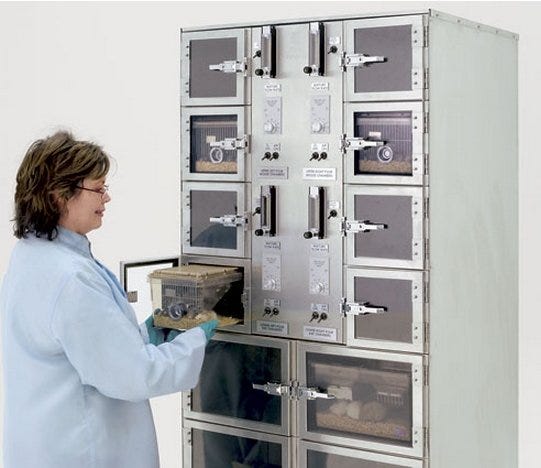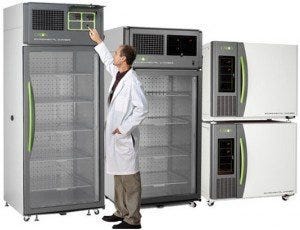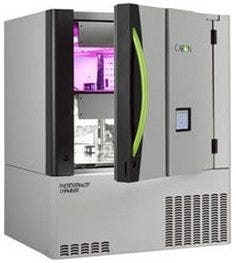
Environmental Test Chambers 101
For decades, environmental test chambers have been used to study products with countless applications in fields such as aerospace, artificial intelligence, automotive, electronics, solar cell, medical, industrial and consumer research. In these industries, the sample or material to be tested must be exposed to defined variations of environmental factors to study the effects, or even as preparation for future studies.
The conditions an environmental test chamber is able to replicate are: temperature set-point (or variations), moisture in the form of relative humidity or rain, electromagnetic radiation, vibration, weathering, salt spraying, sunlight exposure/UV degradation, and vacuum. The type of testing involved will determine the chamber type; chambers come in a variety of sizes and are designed with different functionality and options.
 Prepared specimens or materials are placed inside the chamber and then subjected to defined levels of environmental stimuli to determine the degree to which they react. Resulting by-products are also measured and studied.
Prepared specimens or materials are placed inside the chamber and then subjected to defined levels of environmental stimuli to determine the degree to which they react. Resulting by-products are also measured and studied.
Types of Chambers
Humidity or temperature chambers are used for climatic testing, while vibration and stress chambers are commonly used for mechanical testing, such as evaluating the performance of the product under vibration or shock. “Stress” is often tested using pressure variables, or vacuum.
Stress and vibration chambers are also used for electronics, solar or fuel cell, and automotive products, where test requirements are very demanding. The goal is to push beyond what is “normal” to measure limitations of the material.
The Highly Accelerated Life Test, formally referred to as the HALT test, is undertaken to discover potential flaws and to ultimately improve the product in the design phase. The chamber will simulate various stimuli, such as vibration, burn-in, humidity, voltage, and thermal cycling, which could cause numerous weaknesses in design or production.
Conversely, a compliance test called HASS (Highly Accelerated Stress Screen) is conducted during production to identify flaws prior to commercialization. These tests use temperature and humidity variables to spot potential defects.
Environmental test chambers for manufacturing and production have been used for decades, and are capable of creating stresses that are far greater than what is considered normal for commercial products.
Chamber Designs
Environmental chambers can be designed as walk-in, bench-top, floor-mount, reach-in or drive-in configurations. Depending on the function they perform, they can range in size from portable devices to giant rooms, such as NASA’s vacuum chamber in the Space Power Facility, the largest of its kind.
Floor-mounted and bench-top chambers are the most widely used. While most chambers are made from steel, the materials used for their inner and outer walls vary according to application. When used for food packaging or pharmaceutical applications, it is likely that chambers will have glass doors for visual access. The chambers’ intended applications will also affect the type of heaters, coolers, condensers, evaporators, controllers, sensors and other modules used. Newer test chambers have evolved to keep pace with developments in product testing requirements, such as those for biological and military applications. These chambers are often customized to meet all required environmental testing requirements and devices used for measurement are highly accurate and reliable.
 Compared to their predecessors, newer designs have smaller footprints, and are easier to operate. Their user interfaces are similar to touch-screen Windows displays, as opposed to the legacy scroll electronics. If they are web-enabled, they can be programmed and operated online.
Compared to their predecessors, newer designs have smaller footprints, and are easier to operate. Their user interfaces are similar to touch-screen Windows displays, as opposed to the legacy scroll electronics. If they are web-enabled, they can be programmed and operated online.
Test Chamber Applications
Environmental chambers can be used to test products for the following industry sectors: automotive, building materials, chemicals, electronics, timber, cosmetics, plastics, aerospace, metal, pharmaceuticals, tobacco, textile, packaging industry, biotechnology, bio-tissue engineering, ceramics, human and veterinary medicine, food and beverage, microbiology, surface technology, and plant and insect growth.
In the case of pharmaceutics, food, and cosmetics, environmental and stability chamber monitoring are necessary to comply with rules established by international regulatory agencies. Environmental chambers can measure and control humidity, temperature (mean kinetic temperature, for instance), differential pressure, particle counts, lighting, and gas levels, among others. Advanced aging studies within test chambers help to determine safe shelf-life levels and use-by dates.
In biology and microbiology, environmental test chambers can be used to monitor the effects of light, humidity and other factors on the growth of plants, algae, viruses, insects and small animals (such as the Drosophila, otherwise known as fruit flies). They enable the culture of cells, organs and tissues, as well as plant growth and insect rearing.
The aerospace industry relies on environmental testing chambers to produce vacuum, thermal vacuum and thermal experiments that replicate outer-space conditions so that space system hardware can withstand extreme conditions of pressure and climate. Even portable life support systems for astronauts are tested using environmental chambers. High pressure oxygen systems, cryogenics equipment and other instrumentation are utilized to test effects of reduced pressure and altitude conditions.
Related: How to Automatically Control Vacuum in Test Chambers
In the automotive industry, environmental test chambers are used to simulate conditions such as hot roads and extreme exposure to sunlight. All car manufacturers perform these tests, most of which use drive-in chambers located within the companies’ testing facilities. They reproduce real-world conditions, including normal humidity levels, wind speed, road and air temperatures, as well as extreme conditions, to check the cars’ performance. A dynamometer operates the cars remotely by spinning the wheels and revving the engine as needed. Drive-in vehicle chambers are air-tight and resist contraction and expansion.
Research studies have involved tobacco testing in environmental chambers. These tests measure the effects of the air pollutants released by tobacco products. Medical studies are frequently performed to determine possible effects of toxic by-products.
Aside from complex research protocol used by universities, quarantine bureaus, large manufacturers and research institutions, environmental testing ultimately addresses the quality control inspection of every-day products like electrical appliances, batteries, plastics, paper products, and food.
Most of the products currently available to consumers are taken at face value, with little consideration for the arduous testing that they underwent in order to become commercially available to the end user. This is a testimony to the role that environmental test chambers play in developing and appraising the features and performance of marketable products. They have played a large role in advancing technology to current levels, while ensuring the safety and reliability of the products we use every day.
Terra Universal is the leading expert in the design and fabrication of ISO rated cleanrooms, furnishing and supplies.
Get a free consultation from one of our cleanroom specialists:
Call (714) 459-0731


